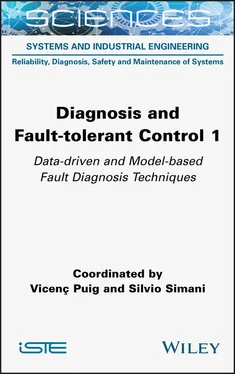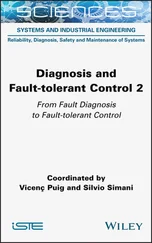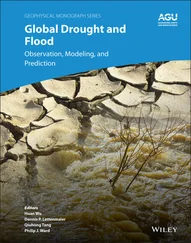In particular, this work studies different approaches to residual generation and fault compensation with the aid of several methodologies. In general, the residual is defined as the output estimation error , obtained by the difference between the measurement of one output and the relative estimate. This work also presents the design of such estimators both in the deterministic and stochastic environment.
The diagnosis procedure may be further specialized for actuators, input or output sensors and process components. In fact, the fault diagnosis of input sensors and actuators uses banks of estimators in high signal-to-noise ratio conditions, or filters, otherwise. The general principle designs the i th reconstructor to be insensitive to the i th signal of the system. On the other hand, output sensor and process component faults affecting a single residual can be detected by means of output observer or filters, driven by a single output and all the inputs of the system.
The book shows how the proposed algorithms can be applied to the FDI and FTC of actuators, process components and input–output sensors of industrial plants.
In particular, the different techniques presented in this book have been tested on time series of data acquired from different simulated and realistic industrial processes, energy conversion systems, power plants, and more general safety critical systems, whose linear mathematical description is obtained by using data-driven and model-based procedures.
Results from simulation show that minimum detectable faults are perfectly compatible with the industrial target of this application.
Finally, the book concludes the proposed research and application topics by summarizing its contributions and achievements, providing some suggestions for possible further research topics as an extension of this work.
This Introduction has provided a common terminology in the fault diagnosis framework in order to comment on some developments in the field of fault detection and diagnosis based on papers selected from the last 30 years. The structure of the 14 chapters and their main contributions have also been outlined briefly.
Babuška, R. (1998). Fuzzy Modeling for Control . Kluwer Academic Publishers. Boston, MA, USA.
Bakiotis, C., Raymond, J., Rault, A. (1979). Parameter identification and discriminant analysis for jet engine mechanical state diagnosis. IEEE Conference on Decision and Control, Fort Lauderdale , Fort Lauderdale, FL, USA.
Basseville, M. and Nikiforov, I.V. (1993). Detection of Abrupt Changes: Theory and Application . Prentice-Hall, Inc., Upper Saddle River, NJ, USA.
Beard, R.V. (1971). Failure accomodation in linear systems through self-reorganisation. Technical Report MVT-71-1, Man Vehicle Lab, Cambridge, MA, USA.
Beghelli, S., Guidorzi, R.P., Soverini, U. (1990). The Frisch scheme in dynamic system identification. Automatica , 26(1), 171–176.
Chen, J. and Patton, R.J. (1999). Robust Model–Based Fault Diagnosis for Dynamic Systems . Kluwer Academic Publishers, Boston, MA, USA.
Chow, E.Y. and Willsky, A.S. (1984). Analytical redundancy and the design of robust detection systems. IEEE Transactions Automatic Control , 29(7), 603–614.
Clark, R.N. (1978). Instrument fault detection. IEEE Transactions on Aerospace &Electronic Systems , 14(3), 456–465.
De Persis, C. and Isidori, A. (2001). A geometric approach to non-linear fault detection and isolation. IEEE Transactions on Automatic Control , 45(6), 853–865.
Ding, X. and Frank, P.M. (1990). Fault detection via factorization approach. Syst. Contr. Lett. , 14(5), 431–436.
Ding, S.X., Jeinsch, T., Frank, P.M., Dind, E.L. (2000). A unified approach to the optimisation of fault detection systems. International Journal of Adaptive Control and Signal Processing , 14(7), 725–745.
Filbert, D. and Metzger, K. (1982). Quality test of systems by parameter estimation. 9th IMEKO Congress , Berlin, Germany.
Frank, P.M. (1990). Fault diagnosis in dynamic systems using analytical and knowledge based redundancy: A survey of some new results. Automatica , 26(3), 459–474.
Frank, P.M., Ding, S.X., Köpper-Seliger, B. (2000). Current developments in the theory of FDI. SAFEPROCESS’00: Preprints of the IFAC Symposium on Fault Detection, Supervision and Safety for Technical Processes , vol. 1, Budapest, Hungary, 16–27.
Geiger, G. (1982). Monitoring of an elecrical driven pump using continuous-time parameter estimation models. 6th IFAC Symposium on Identification and Parameter Estimation , Washington, Pergamon Press, Oxford, UK.
Gertler, J. (1988). Survey of model-based failure detection and isolation in complex plants. IEEE Control System Magazine , 8(6), 3–11.
Gertler, J. (1991). Generating directional residuals with dynamic parity equations. IFAC/IMACS Symposium Proceedings: SAFEPROCESS’91 , Baden-Baden, Germany.
Gertler, J. (1998). Fault Detection and Diagnosis in Engineering Systems . Marcel Dekker, New York, USA.
Himmelblau, D.M. (1978). Fault Diagnosis in Chemical and Petrochemical Processes . Elsevier , Amsterdam, The Netherlands.
Höfling, T. and Pfeufer, T. (1994). Detection of additive and multiplicative faults – Parity space vs. parameter estimation. IFAC Symposium Proceedings: SAFEPROCESS’94 , Espoo, Finland.
Hohmann, H. (1977). Automatic monitoring and failure diagnosis for machine tools. Dissertation, T.H. Darmstadt, Germany [in German].
IFI (1983). Reliable computing and fault tolerance. Meeting, IFI, Como, Italy.
Isermann, R. (1984). Process fault detection based on modeling and estimation methods: A survey. Automatica , 20(4), 387–404.
Isermann, R. (1994a). Integration of fault detection and diagnosis methods. IFAC Symposium Proceedings SAFEPROCESS ’94 , Espoo, Finland.
Isermann, R. (1994b). Supervision and fault diagnosis. Paper, VDI-Verlag, Düsseldorf [in German].
Isermann, R. (1997). Supervision, fault detection and fault diagnosis methods: An introduction. Control Engineering Practice , 5(5), 639–652.
Isermann, R. and Ballé, P. (1997). Trends in the application of model-based fault detection and diagnosis of technical processes. Control Engineering Practice , 5(5), 709–719.
Isermann, R. and Freyermuth, B. (eds) (1992). Fault Detection, Supervision and Safety for Technical Processes . Pergamon Press, Oxford, UK.
Jazwinski, A.H. (1970). Stochastic Processes and Filtering Theory . Academic Press, New York, USA.
Jones, H.L. (1973). Failure detection in linear systems. PhD Thesis, Department of Aeronautics, M.I.T., Cambridge, MA, USA.
Kalman, R.E. (1982). System identification from noisy data. In Dynamic Systems II, a University of Florida International Symposium , Bednarek, A.R., Cesari, L. (eds). Academic Press, New York, USA.
Kalman, R.E. (1990). Nine lectures on identification. In Lecture Notes on Economics and Mathematical System , Fandel, G. and Trockel, W. (eds). Springer, Berlin, Germany.
Liu, G.P. and Patton, R.J. (1998). Eigenstructure Assignment for Control System Design . John Wiley &Sons, Chichester, UK.
Ljung, L. (1999). System Identification: Theory for the User , 2nd edition. Prentice Hall, Englewood Cliffs, N.J, USA.
Luenberger, D.G. (1979). Introduction to Dynamic Systems: Theory, Models and Application , John Wiley &Sons, New York, USA.
Massoumnia, M., Verghese, G.C., Willsky, A.S. (1989). Failure detection and identification. IEEE Transactions on Automatic Control , 34, 316–321.
Читать дальше












